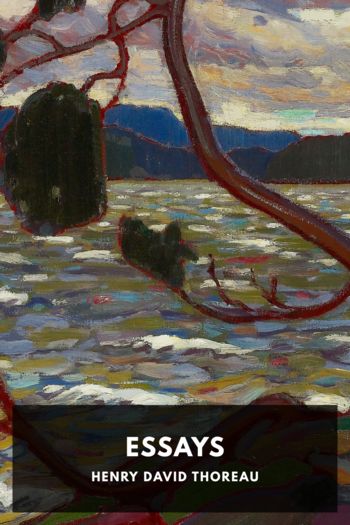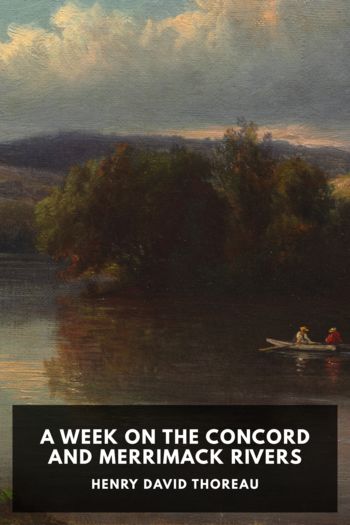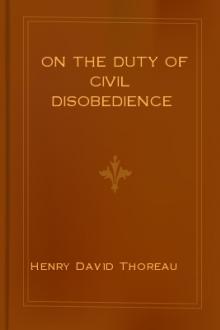Essays by Henry David Thoreau (feel good books .txt) 📕

Description
Though perhaps most famous for Walden, Henry David Thoreau was also a prolific essayist. Many of his essays touch on subjects similar to his famous book: long walks through nature, things found in moonlight that are invisible and unheard during the day, his preference for wild apples over domestic ones. In many ways he prefigured environmentalism, expressing his love for untouched nature and lamenting what the encroachment of man and cities were doing to it.
He also had strong opinions on many other subjects. One of his most famous essays, “On the Duty of Civil Disobedience,” was written as a result of his going to jail for refusing to pay several years’ worth of poll taxes. One of the primary reasons for his refusal was his holding the government in contempt for its support of slavery, and several of his other essays express support and admiration for John Brown, who thought to start a slave revolt when he attacked Harper’s Ferry in 1859.
Whether discussing trees in a forest, slavery, or the works of Thomas Carlyle, Thoreau’s essays are deeply personal and full of keen observations, often in poetic language. They give a sense of the man expressing them as being much more than the views being expressed.
Read free book «Essays by Henry David Thoreau (feel good books .txt) 📕» - read online or download for free at americanlibrarybooks.com
- Author: Henry David Thoreau
Read book online «Essays by Henry David Thoreau (feel good books .txt) 📕». Author - Henry David Thoreau
Shall the names of so many of our colors continue to be derived from those of obscure foreign localities, as Naples yellow, Prussian blue, raw Sienna, burnt Umber, Gamboge?—(surely the Tyrian purple must have faded by this time)—or from comparatively trivial articles of commerce—chocolate, lemon, coffee, cinnamon, claret?—(shall we compare our hickory to a lemon, or a lemon to a hickory?)—or from ores and oxides which few ever see? Shall we so often, when describing to our neighbors the color of something we have seen, refer them, not to some natural object in our neighborhood, but perchance to a bit of earth fetched from the other side of the planet, which possibly they may find at the apothecary’s, but which probably neither they nor we ever saw? Have we not an earth under our feet—ay, and a sky over our heads? Or is the last all ultramarine? What do we know of sapphire, amethyst, emerald, ruby, amber, and the like—most of us who take these names in vain? Leave these precious words to cabinet-keepers, virtuosos, and maids-of-honor—to the Nabobs, Begums, and Chobdars of Hindostan, or wherever else. I do not see why, since America and her autumn woods have been discovered, our leaves should not compete with the precious stones in giving names to colors; and, indeed, I believe that in course of time the names of some of our trees and shrubs, as well as flowers, will get into our popular chromatic nomenclature.
But of much more importance than a knowledge of the names and distinctions of color is the joy and exhilaration which these colored leaves excite. Already these brilliant trees throughout the street, without any more variety, are at least equal to an annual festival and holiday, or a week of such. These are cheap and innocent gala-days, celebrated by one and all without the aid of committees or marshals, such a show as may safely be licensed, not attracting gamblers or rum-sellers, not requiring any special police to keep the peace. And poor indeed must be that New England village’s October which has not the maple in its streets. This October festival costs no powder, nor ringing of bells, but every tree is a living liberty-pole on which a thousand bright flags are waving.
No wonder that we must have our annual Cattle-Show, and Fall Training, and perhaps Cornwallis, our September Courts, and the like. Nature herself holds her annual fair in October, not only in the streets, but in every hollow and on every hillside. When lately we looked into that red-maple swamp all ablaze, where the trees were clothed in their vestures of most dazzling tints, did it not suggest a thousand gypsies beneath—a race capable of wild delight—or even the fabled fawns, satyrs, and wood-nymphs come back to earth? Or was it only a congregation of wearied wood-choppers, or of proprietors come to inspect their lots, that we thought of? Or, earlier still, when we paddled on the river through that fine-grained September air, did there not appear to be something new going on under the sparkling surface of the stream, a shaking of props, at least, so that we made haste in order to be up in time? Did not the rows of yellowing willows and button-bushes on each side seem like rows of booths, under which, perhaps, some fluviatile egg-pop equally yellow was effervescing? Did not all these suggest that man’s spirits should rise as high as nature’s—should hang out their flag, and the routine of his life be interrupted by an analogous expression of joy and hilarity?
No annual training or muster of soldiery, no celebration with its scarfs and banners, could import into the town a hundredth part of the annual splendor of our October. We have only to set the trees, or let them stand, and Nature will find the colored drapery—flags of all her nations, some of whose private signals hardly the botanist can read—while we walk under the triumphal arches of the elms. Leave it to Nature to appoint the days, whether the same as in neighboring states or not, and let the clergy read her proclamations, if they can understand them. Behold what a brilliant drapery is her woodbine flag! What public-spirited merchant, think you, has contributed this part of the show? There is no handsomer shingling and paint than this vine, at present covering a whole side of some houses. I do not believe that the Ivy never sere is comparable to it. No wonder it has been extensively introduced into London. Let us have a good many maples and hickories and scarlet oaks, then, I say. Blaze away! Shall that dirty roll of bunting in the gun-house be all the colors a village can display? A village is not complete unless it have these trees to mark the season in it. They are important, like the town-clock. A village that has them not will not be found to work well. It has a screw loose, an essential part is wanting. Let us have willows for spring, elms for summer, maples and walnuts and tupeloes for autumn, evergreens for winter, and oaks for all seasons. What is





Comments (0)